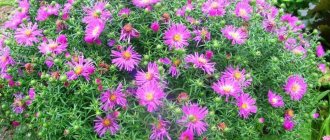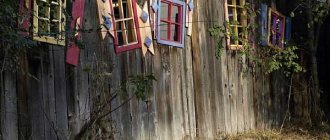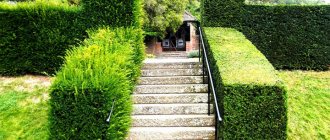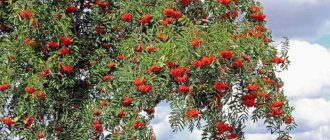Rarely a city park, square, summer cottage, courtyard of a country house, park or recreation area cannot boast of a chic rowan bush. In Russia, everyone has it, like a business card. There are quite a lot of reasons here. The common rowan is a common and beloved deciduous tree, distinguished by its spectacular, eye-catching beauty. It is no coincidence that in landscape design it occupies the top positions in popularity and undeniable advantages. The tree is compact and well formed. Autumn is the peak of the mountain ash charm. Its purplish leaves frame red, yellow or black berry clusters. Such a landscape is worthy only of the brush of a great artist.
Rowan in landscape design
Rarely a city park, square, summer cottage, courtyard of a country house, park or recreation area cannot boast of a chic rowan bush. In Russia, everyone has it, like a business card. There are quite a lot of reasons here. The common rowan is a common and beloved deciduous tree, distinguished by its spectacular, eye-catching beauty. It is no coincidence that in landscape design it occupies the top positions in popularity and undeniable advantages. The tree is compact and well formed. Autumn is the peak of the mountain ash charm. Its purplish leaves frame red, yellow or black berry clusters. Such a landscape is worthy only of the brush of a great artist.
Common rowan description
If you add to the unusual beauty the beneficial qualities of the rowan tree that it possesses, then its price cannot be added up. This is a common plant, endowed with decorative properties, invaluable for landscape design. It is also unpretentious to soils, grows and develops well on any of them:
- Its fruits are used in winemaking, folk medicine, pharmacology, and cooking.
- And what irreplaceable help she provides in organizing food for the birds remaining for the winter.
- Rowan can be black-fruited or red-fruited. The first variety can be found in orchards. It has an excellent property - to stabilize high blood pressure.
Description of mountain ash
Many summer residents are puzzled by the question: is rowan a tree or a shrub? In fact, this is a tree, less often a shrub:
- The height of the rowan reaches five or ten meters, but can grow up to twelve.
- Its openwork crown is round in shape.
- Young branches are covered with a red edge with a gray tint.
- The mature plant has shiny, smooth yellow-gray or gray-brown bark.
- The tree has a deep root system and does not need to be watered.
Since the plant grows in forests, it is advisable to fertilize it with leaf humus. This will be the key to a countless harvest. The most delicious rowan of sweet varieties.
The tree has fluffy felt buds. Leaves reach 20 cm in length:
- They consist of 7-15 leaves.
- Their color is green, often matte.
In autumn they turn golden and red.
The plant has numerous flowers, which are collected in inflorescences with a diameter of 10 cm:
- They are located at the tips of the shoots.
- The receptacle has a narrow-like shape.
- The calyx consists of 5 broadly triangular sepals.
- The diameter of the white corolla is 0.8-1.5 cm.
While the rowan tree is blooming, it emits an unpleasant odor due to trimethylamine gas. It produces berries in clusters. Each of them is a red-orange juicy spherical apple, the diameter of which is 1 cm:
- Rowan begins to bear fruit after 4-5 years.
- They reach full maturity by autumn.
- Full fruiting of rowan is achieved by 15-25 years.
At this time, up to one hundred kilograms of a full-fledged useful product is collected from it. The rowan harvest occurs in a year or two.
Varieties and decorative forms of rowan
The most famous variety is the common rowan. This is a medium-height tree with lacy foliage and bright red berries collected in clusters. Several ornamental varieties have been developed based on the mountain ash:
- Nevezhinskaya red. A tree with brown bark and a neat crown. It tolerates cutting and shaping well. Grown as a fruit variety. The cube-shaped berries are orange, sweet, with a slight sourness. The red form has the sweetest fruits, their color is deep scarlet. The yellow-fruited form is decorative, the berries are bright, yellow, golden, with a sweet and sour taste, and contain a lot of vitamin C;
- Kene. A compact variety developed in China. The height of the tree does not exceed 3 m. It is unpretentious, grows well on sandy or turf soil, even young seedlings can withstand sunlight without being burned. The color of the berries is white, the foliage has a rich, dark green hue, which can turn brown or scarlet in the fall. Its small size makes it possible to grow Kene rowan as part of any decorative compositions, next to front gardens, recreation areas, and gazebos;
- Garnet-shaped. Brought out as a result of selection between ordinary rowan and hawthorn. These are low trees (rarely grow above 4 m) with neat crowns. The color of the fruit is darker, pomegranate;
- Scandinavian. A low tree with a slender trunk. The crown is compact, neat, with silvery foliage (may turn yellow in autumn). The berries are orange in color, collected in large clusters. Even young trees bear fruit abundantly;
- Arnoldina. The variety was bred in Holland, the fruits can be yellow, pink, orange, white, brownish;
- Fastigiata. British selection, the variety is characterized by vertical growth of branches. The foliage is dark green. The crown shape is pyramidal.
Rowan has several decorative forms, including weeping (the crown is formed by drooping branches), pyramidal, with large fruits (Russian). The tree can be grown on a trunk. With regular trimming, the crown will be compact and very dense. Without pruning, elongated, drooping shoots will form. Common rowan adapts well to any growth conditions, and therefore it can be used in arbosculpture: “braiding” shoots, changing the direction of trunk growth.
Where does the common rowan grow?
Translated from Latin, the word “rowan” means “to attract or catch birds,” since its berries became a kind of bait for catching them. To the question of where the rowan grows, you won’t have to look for the answer for long, since it is distributed all over the world:
- It grows in the Caucasus.
- In Western Asia.
- Well known in Europe.
To understand whether a mountain ash is a tree or a bush, you just need to know that, once in the Far North, it reaches the border in the mountains where the vegetation ends and in these places takes the form of a bush. This suggests that the tree grows in places with a temperate climate, and the shrub grows in the harsh conditions of the North.
Rowan tree or shrub in Russia is common in the forest and forest-steppe zones of European territories, in the North Caucasus and the Urals. You can find her:
- on the edges between bushes;
- in the undergrowth;
- in forest clearings;
- among deciduous and mixed forests;
- it grows alone, without creating thickets.
What types of rowan are there?
There are a lot of different types of rowan. There are only 14 varieties of rowan that were bred as a result of breeding work. They were studied by the great Russian biologist I.V. Michurin, who obtained fundamentally new varieties by crossing rowan plants with red shadberry, pear, and hawthorn. The most common species obtained by I.V. Michurin, the following are considered:
- “Michurinskaya dessert”, sweet rowan.
- “Pomegranate”, similar in color to pomegranate.
- "Burka".
- “Liquor” rowan, which has black, sweet berries.
Later, the selection of rowan trees and shrubs began in the city of Michurinsk. Scientists have created varieties:
The varieties were created by crossing the Nevezhinsky and Moravian varieties of mountain ash. Since rowan has been propagating, new varieties of rowan have been created from these two varieties.
In the Russian village of Nevezhino, they discovered non-bitter varieties, like mountain ash. From here these varieties spread throughout Russia. Some were obtained using the folk method and were registered:
Biologist E.M. Petrov was involved in obtaining new varieties of mountain ash and described it, who obtained a number of hybrids:
The most popular types of rowan: European types of rowan
The most widely cultivated species, the mountain ash (S. aucuparia), comes from Europe. There are many subspecies that are offered as species, including Madeira rowan (S. maderensis), Pohuashan rowan (S. pohuashanensis), Amur rowan (S. amurensis), and Kamchatka rowan (S. kamtschatcensis).
Mountain ash (S. apiculata)
Considering that the common mountain ash (S. aucuparia) is found from the British Isles to eastern Russia, some differences in plants are inevitable, even within the same species.
How to plant rowan
To properly plant a rowan tree or bush, you need to rely on certain rules. To plant trees in the spring, the hole must be prepared in the fall:
- For low-growing varieties, a recess of 80 cm in diameter and 50 cm in depth will be sufficient.
- Vigorous stalks of mountain ash are planted in holes with a diameter of 100 cm and a depth of 60 cm.
- The following is placed in the pit: potassium sulfate (0.1-0.15 kg), superphosphate (0.8-2 kg), manure (20 kg - 2 buckets).
- The soil is mixed well with manure. 2/3 of mineral fertilizers are applied to the bottom, 1/3 is applied to the lower layer of soil, which is poured into a hill.
In order not to injure the plant, mineral fertilizers are not applied to the soil where the roots are. A common rowan tree is planted, the stem of which has reached 130 cm, taking into account its preferences. The best place for it will be the north or east side. When planting several seedlings, the distance between them should be 4 m. In order for rowan to please with a good harvest, you need to choose a sunny place for the plant:
- The plant does not tolerate wet, dry, saline, or peaty areas.
- Groundwater cannot be higher than 2 m.
Seedlings must also meet certain requirements:
- They must be fresh, free of root damage and leaves.
- Their root system should be branched.
- The rowan tree should be 120 cm in height with a trunk diameter of 1.2 cm.
- The standard of two-year-old seedlings is 40-60 cm.
- The root collar is 1 cm in diameter.
- The trunk has a diameter of 2.4 cm.
- 7 large roots 40 cm long.
Before you start planting rowan, in the center of the recess for the plant you need to rake the soil into the center, straightening the roots on it, and then pour the soil so that the root collar and soil are at the same height. It is impossible to bury the seedling too deeply, as the plant will begin to produce abundant growth, which must be systematically removed to the ground. When adding soil during planting, you need to thoroughly moisten it. This will prevent you from leaving empty spaces in the roots, and the soil will fall on the roots. Tall seedlings need to be protected by driving poles into the ground, bending them to the plant and tying them up. It is very important, after planting rowan, to water it abundantly. On dry days, rowan needs to be watered up to 3-4 times.
Planting and care
It is necessary to plant fieldfare with the arrival of spring, or in the fall, after dropping the leaves. Dig a hole about 50 cm deep and 60-70 cm wide. A layer of drainage is poured onto the bottom, a layer of humus with soil is placed on top, and a seedling is planted, covering it with soil.
Rowan-leafed fieldfare is very unpretentious in care:
- The most important condition for its successful growth is soil moisture. Therefore, to prevent the soil around the bushes from drying out, after watering it should be mulched with compost or peat.
- Also, the ground around the bushes needs to be loosened shallowly about once a month. It is not worth digging up the soil around the fieldfare, since its roots are close to the surface.
- You should also remove weeds around the bush; it does not like them even in adulthood.
- Fieldfare needs to be fertilized 2-3 times per season with peat, compost or organic fertilizers.
- The bush should be pruned once a year to give it shape. Perform pruning in the fall.
- To ensure that the fieldfare always looks good, faded panicles are cut off.
- Fieldfare does not need preparation for winter.
Rowan care
When caring for a plant, you must remember that the tree trunk circle becomes wider as the tree grows. If its diameter at the time of planting was one and a half meters, then in subsequent years it will be 1 m wider than the crown:
- In the tree trunk circle, it is necessary to dig up the soil in autumn and spring by 10-15 cm, so as not to touch the roots.
- From spring to autumn you need to loosen the soil 3-4 times by 5-6 cm.
- Mulching will retain moisture well. You can fill the tree trunk circle with manure or peat to a depth of 8-10 cm.
When cultivating the soil in the spring, you need to add fertilizers to the tree trunk circle: manure, potassium, nitrogen. When caring for a tree, you can use slurry of manure, diluted in a ratio of 1: 2-3, and bird droppings, diluted in a ratio of 1: 10-12, as a top dressing.
During pruning, broken shoots are removed from the bush. This is done from the beginning of the season, as well as during the fruiting period, when the crown is very thick. If the plant is under control, it is also regularly pruned.
During seasons of high humidity, a coating of rust appears on the leaves of rowan, which is sprayed with Bordeaux mixture.
When destroying pests, it is necessary to take effective measures:
- Shake beetles from trees onto the litter and collect nests.
- Remove fruits eaten by caterpillars along with them.
- In spring and autumn, dig up the soil to destroy the pupae.
- Clean up and burn fallen leaves in a timely manner.
Significant harm is caused to it by ants, which carry aphids onto the rowan leaves and spread them throughout the entire area. Aphids cause leaf curl. You cannot spray the moment the plant blooms. It is necessary to spray with preparations in a timely manner (Iskra, Iskra-bio, Fitoverm).
The most popular types of rowan: Himalayan types of rowan
Himalayan species are one of the most attractive rowan species with brightly colored fruits and smaller plant sizes. The leaves are more fern-like and have fantastic fall colors. Two notable red-fruited Asian species: the sargent rowan (S. sargentiana) (pictured with the article) and the mixed rowan (S. commixta). Both reach about 10 m.
Mixed rowan (S. commixta)
Sargent rowan is distinguished by the largest and most spectacular clusters of fruits. Another larger Chinese species is the Hubei mountain ash (S. hupehensis) with beautiful bluish foliage. The fruits have a bright pink hue, like the similar S. pseudohupehensis, which also has pink-tinged berries.
Hubei mountain ash (S. hupehensis)
White-fruited species include Chinese Forrest rowan (S. forrestii) and Bulley's rowan (S. bulleyana). In terms of growth structure and foliage, they are not much different from European mountain ash species.
Pseudovilmorinii (S. pseudovilmorinii)
Collectors have long tried small Himalayan species in their gardens. Both Koehne's rowan (S. koehniana), Vilmorin's rowan (S. Vilmorinii), and Pratt's rowan (S. prattii) produce white fruits with a pink tint and present an absolutely stunning sight in the fall.
Rowan Koehniana (S. koehniana)
Kashmir rowan (S. cashmeriana) has pinkish flowers and fairly large white berries; in our conditions it grows as a low shrub up to 2.5 m with very lacy leaves.
Pratt's mountain ash (S. prattii)
Sichuan mountain ash (S. setschwanensis) and Roeder's mountain ash (S. rehderiana) have glossy foliage, white to pink berries and showy fall color.
Rowan Takhtajanii (S. takhtajanii)
The smallest species can be called shortened rowan (S. reducta) and black-leaved rowan (S. poteriifolia). The first will reach 1 m, and the second can be encountered by climbers in the form of a prostrate bush 15 cm high (it easily reaches up to 2.7 m in other conditions). Both have very fine foliage, white to pink fruit, and beautiful fall color. These are ideal shrubs for rock gardens.
Rowan (S. reducta)
It should be noted that all of these Asian species are zone 5, but since they are rarely grown in Russia, hardiness ratings may vary specifically for your garden.
How does mountain ash reproduce?
Rowan propagation is carried out using several methods:
- Its seeds are bred in the fall.
- in cold weather or at the beginning of summer, the plant is propagated by rowan cuttings;
- Rowan propagation is carried out in the summer, through grafting through a dormant bud;
- in the cold season, using ordinary grafting, the rootstock is an ordinary rowan with a strong root system.
To propagate rowan by cuttings or eyes, this must be done in August. The rootstock is the root shoot of the tree, which is separated from the main plant.
Rowan, which is propagated by seeds, grows much faster than seedlings and cuttings. After 3-4 years, the seedling is grafted. Sowing is done before winter, after collecting the seeds. They are crushed on a sheet of paper and placed in the soil along with it, covered with soil on top. In order not to collect fruits on the stairs, it is better to trim the top of the tree to the required size.
The way the common rowan looks, especially at the peak of its beauty, on fine autumn days, makes this tree very noticeable. It is so attractive that it is widely used in landscape design. The trees look good as a background for ornamental shrubs (spirea, fieldfare, dogwood, barberry). Small trees look great as tapeworms on lawns and are great next to gazebos. A rowan planted in the front garden acts as a talisman for the house against all sorts of misfortunes.
It goes well with oaks, lindens, fir, spruce. It makes excellent living gazebos. Varieties of weeping rowan created by grafting are cozy forms of landscape design. In our nursery of ornamental plants and seedlings, all varieties of rowan are grown. What a rowan tree a client likes looks like can be found in the company’s online catalog with a photo and description of the plant. Call us. The company will help you choose the plant you like with delivery to your address and a payment form convenient for the client.
Fieldfare bush - description
The fieldfare plant is a deciduous shrub up to 3 m high, which, due to its ability to produce a large number of root shoots, forms spectacular dense thickets. The shoots of the fieldfare are geniculate-twisting, yellowish-gray, the leaves are compound, imparipinnate, consisting of 9-13 pairs of serrate or double-serrate leaves. Numerous small white or creamy flowers are collected in pyramidal panicles. Fieldfare fruits are leaflets.
Fieldfare in landscape design is used for single and group plantings, as well as for hedges, strengthening slopes and decorating ponds.
When to plant fieldfare in the ground.
Ornamental fieldfare is planted in open ground in the spring, before sap flow, or in the fall, after leaf fall.
The plant's shade tolerance allows it to be placed under large trees. Fieldfare shrubs grow normally both on dense clay soils and in soil with excess moisture.
How to plant field ash.
The dimensions of the planting pit for fieldfare should be approximately 70x70 cm, and the depth should not be more than half a meter. In group planting, the distance between plants is maintained at least 1 m. Since fieldfare, like thorns, is prone to uncontrolled growth, it is advisable to cover the sides of the pit with metal or slate sheets. A layer of drainage material is placed at the bottom of the hole, then a layer of soil mixed with compost or humus is placed, after which the root system of the seedling is lowered into the hole and the free space is filled with soil mixed with organic matter. After planting, the root collar of the seedling should be 2-3 cm above the surface of the site. Pour 2 buckets of water under the seedling, wait until it is absorbed, and mulch the surface around the plant.
How to grow fieldfare.
Planting and caring for fieldfare will not cause you any trouble. Keep the soil around the bushes loose and slightly moist, remove weeds and root growth, feed the bush if it grows in poor soil, and shape the bushes by pruning if necessary.
Water fieldfare abundantly, especially in dry weather. Feed the plant in small portions at least twice a season, applying fertilizers superficially or covering them shallowly. Peat, compost or humus are used as fertilizer, but sometimes mineral complexes can also be used.
Faded fieldfare inflorescences should be removed, as they significantly reduce the decorative value of the shrub. For sanitary purposes, fieldfare is pruned in early spring: damaged, dry branches that thicken the bush or those affected by pests and diseases are removed. If fieldfare is not thinned out, this will lead to the formation of weak, thin and rapidly aging shoots. Fieldfare tolerates haircuts well, including radical rejuvenating ones. Don't forget to regularly remove root growth.
Transplanting fieldfare in the garden.
Replanting the fieldfare will not cause any harm. This procedure can be combined with dividing the bush. In spring or autumn, dig a new hole for the plant in advance, place drainage in it and prepare fertile soil by mixing the soil removed from the hole with humus or compost. Then dig up the fieldfare, if necessary, divide it into parts so that each of them has developed roots and strong shoots, treat the cuts with crushed coal and plant the sections in their designated places. If you don’t need to divide the bush, simply transplant it into a prepared hole, fill the space with soil mixture, compact the surface around the bush and water the plant generously.
Pests and diseases of fieldfare.
Having high phytoncidal properties, fieldfare is very resistant to diseases and pests, but sometimes it can be affected by spider mites or green aphids. Both mites and aphids feed on the cell sap of the plant, causing it to wither, its leaves turn yellow, and its shoots become deformed. In addition, sucking pests can be carriers of the incurable disease viral mosaic, and then all you have to do is dig up the bush and burn it. Pests are destroyed with a solution of Mitaka or Fitoverm.
Tree and shrub compositions with rowan will become a bright decoration of the landscape
Tree and shrub compositions with rowan will become a bright decoration of the landscape
Rowan is an unusually picturesque plant that can be admired all year round. In spring it pleases with lush green leaves and delicate white inflorescences, in summer and autumn with ripening berries and exciting changes in colors.
Number of votes: 0
Tree and shrub compositions with rowan
Rowan has excellent decorative properties; it is especially beautiful in the fall, decorated with bright yellow and red fruits. This spectacular tree grows up to 15 m in height, can have a spherical or pyramidal crown, and in the spring it is covered with delicate inflorescences with white or pink flowers.
Rowan combines very beautifully with coniferous plants; it also looks interesting next to birch, ash and other deciduous trees or flowering shrubs. Therefore, it is widely used to create interesting tree and shrub compositions.
You can make a spectacular composition from several rowan trees by planting spirea, barberry, lilac and other beautiful flowering plants between them. In group plantings, rowan berries can decorate the foreground of taller trees or create a bright background for low-growing shrubs.
Source of the article: https://landshaftm.ru/news/svoimi-rukami/drevesno-kustarnikovyie-kompoziczii-s-ryabinoj-stanut-yarkim-ukrasheniem-landshafta











